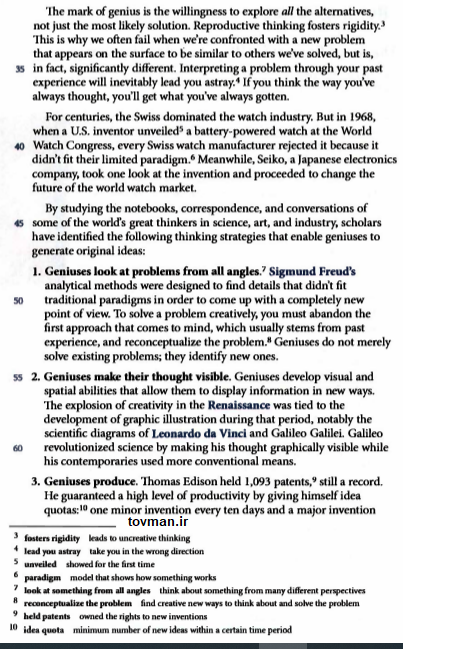
The Art of Genius: Six Ways to Think Like Einstein
هنر نوابغ: شش روش فکر کردن مثل انیشتین نوشته شده
توسط میشل میچالک by Michael Michalke



How do geniuses come up with ideas? What links the thinking style that produced Mona Lisa with the one that spawned۱ the theory of relativity? What can we learn from the thinking strategies of the Galileos, Edisons, and Mozarts (see painting) of history
چگونه نوابغ ایده ها را بوجود می آورند؟ چه ارتباطی بین سبک تفکری که مونی لیزا را بوجود آورده با آن که نظریه نسبیت را بوجود آورده است وجود دارد؟ چه چیزی ما می توانیم از استراتژِی های تفکر گالیه، ادیسون و موزارت در تاریخ بیاموزیم ( تصویر را ببینید).
For years, scholars tried to study genius by analyzing statistics. In ۱۹۰۴, Havelock Ellis noted that most geniuses were fathered by men older than ۳۰, had mothers younger than ۲۵, and usually were sickly children. Other researchers reported that many were celibate۲ (Descartes), fatherless (Dickens), or motherless (Darwin). In the end, the data illuminated nothing
سال ها محققان با تحلیل آماری نوابغ را مورد مطالعه قرار داده اند. در ۱۹۰۴ هاولاک الیس اشاره کرد که بیشتر نوابغ از پدرانی که بیش از ۳۰ سال سال سن و مادرانی که کمتر از ۲۵ سال سن داشتند متولد شده اند و معمولاً کودکان ناخوشی بوده اند. محققان دیگری اعلام داشته اند که خیلی از آنها مجرد (دکارت)، یتیم(دیکنز) یا بی مادر(داروین) بوده اند. در پایان داده ها چیزی نشان ندادند.
Academics also tried to measure the links between intelligence and genius. But they found that run-of-the-mill physicists had IQs much higher than Nobel Prize winner and extraordinary genius Richard Feynman, whose IQ was a merely respectable ۱۲۲. Genius is not about mastering languages at the age of seven or even being especially smart. Creativity is not the same as intelligence.
دانشمندان همچنین تلاش کردند ارتباط بین هوش و نبوغ را اندازه گیری کنند. اما آنها دریافتند که فیزیکدانان عادی از ریچارد فینمن برنده جایزه نوبل و نابغه عالی با آی کو قابل قبول ۱۲۲؛ آی کیوی بیشتری دارند. نبوغ درباره تسلط بر ۱۴ زبان در سن هفت سالگی یا باهوش بودن بطور خاص نیست. خلاقیت همان هوش نیست.
Most people of average intelligence can figure out the expected conventional response to a given problem. For example, when asked, "What is one-half of ۱۳?" most of us immediately answer six and one-half. That's because we tend to think reproductively. When confronted with a problem, we sift through what we've been taught and what has worked for us in the past, select the most promising approach, and work toward the solution
اکثریت افراد با هوش متوسط می توانند پاسخ های متعارف مورد انتظار را بفهمند. به عنوان مثال، وقتی پرسیده می شود، نصف ۱۳ چند است؟ بیشتر ما فوراً پاسخ می دهیم شش و نیم. زیرا ما تمایل داریم بطور موثری فکر کنیم. وقتی که با یک مشکل مواجه می شویم، همه آنچه را که یاد گرفته ایم و آنچه را که در گذشته برای ما موثر بوده، بررسی می کنیم و رویکردهای که بیشتر نوید بخش اند و برای حل آن موثرند انتخاب می کنیم.
Geniuses, on the other hand, think productively. They ask: "How many different ways can I look at this probleni?" and "How many ways can I solve it?" A productive thinker, for example, would find a number of ways to "halve ۱۳":
۶.۵
۱/۳ =land ۳
THIRTEEN =۴
XI/II= ۱۱ and ۲
از طرف دیگر نوابغ بصورت سودمند فکر می کنند. آنها می پرسند با چند راه مختلف می توانم به این مشکل نگاه کنم؟ و با چند راه مختلف می توانم آنها را حل کنم. یک متفکر کارآمد به عنوان مثال روش های محتلفی برای ۱۳ دارد: ۶.۵
۱/۳ =land ۳
THIRTEEN =۴
XI/II= ۱۱ and ۲
The mark of genius is the willingness to explore all the alternatives, not just the most likely solution. Reproductive thinking fosters rigidity. This is why we often fail when we're confronted with a new problem that appears on the surface to be similar to others we've solved, but is in fact, significantly different. Interpreting a problem through your past experience will inevitably lead you astray. If you think the way you've always thought, you'll get what you've always gotten
نشانه نبوغ تمایل به بررسی کردن همه انتخاب هاست، نه فقط محتمل ترین راه حل. تفکر بازساختی موجب تفکر غیرخلاق می شود. به همین دلیل ما وقتی با یک مشکل جدیدی که در ظاهر شبیه آنهائی است که ما قبلاٌ حل کرده ایم روبرو می شویم، اغلب شکست می خوریم زیرا در حقیقت آنها بسیار با هم متفاوتند. تفسیر یک مشکل در میان تجربیات گذشتتان شما را به مسیر اشتباهی هدایت خواهد کرد. اگر شما به روشی که همیشه تفکر می کنید، فکر کنید، همیشه به آنچه همیشه رسیده اید، خواهید رسید.
For centuries, the Swiss dominated the watch industry. But in ۱۹۶۸, when a U.S. inventor unveileds a battery-powered watch at the World Watch Congress, every Swiss watch manufacturer rejected it because it didn't fit their limited paradigm . Meanwhile, Seiko, a Japanese electronics company, took one look at the invention and proceeded to change the future of the world watch market
قرن ها سویس بر صنعت ساعت حکمفرما بود. اما در سال ۱۹۶۸ وقتی یک مخترع آمریکایی یک ساعت مچی دارای باطری را در کنگره جهانی ساعت رونمائی کرد، همه سازندگان ساعت مچی سویسی آن را نپذیرفتند، زیرا آن با الگوی محدود آنها متناسب نبود. در همین حین سیسکو یک شرکت الکترونیکی ژاپنی نگاهی به این اختراع انداخت و اقدام به تغییر آینده بازار جهانی ساعت مچی کرد.
By studying the notebooks, correspondence, and conversations of some of the world's great thinkers in science, art, and industry, scholars have identified the following thinking strategies that enable geniuses to generate original ideas:
با مطالعه دفترچه ها، مکاتبات و مکالمات تعدادی از متفکران بزرگ جهان در هنر، صنعت، محققان نشان داده اند که استراتژی های فکری زیر نوابغ را قادر می سازد تا ایده های اصلی را ایجاد کنند:
I. Geniuses look at problems from all angles. Sigmund Freud's analytical methods were designed to find details that didn't fit traditional paradigms in order to come up with a completely new point of view. To solve a problem creatively, you must abandon the first approach that comes to mind, which usually stems from past experience, and reconceptualize the problem. Geniuses do not merely solve existing problems; they identify new ones
۱- نوابغ به مشکلات از جنبه های مختلف نگاه می کنند. روش های تحلیلی زیگموند فروید برای یافتن جزئیاتی که متناسب با الگوهای سنی نیست طراحی شده است تا یک نقطه نظر کاملاً جدید را ارائه دهد. برای حل خلاقانه یک مشکل، باید رویکرد نخستینی که به ذهن شما می آید و معمولاً از تجربیات گذشته شما نشات گرفته است را رها کنید و راه خلاقانه جدیدی برای مشکل پیدا کنید. نوابغ صرفاً مشکل موجود را حل نمی کنند؛ آنها موارد جدید را شناسایی می کنند.
. ۲Geniuses make their thought visible. Geniuses develop visual and spatial abilities that allow them to display information in new ways. The explosion of creativity in the Renaissance was tied to the development of graphic illustration during that period, notably the scientific diagrams of Leonardo da Vinci and Galileo Galilei. Galileo revolutionized science by making his thought graphically visible while his contemporaries used more conventional means
۲- نوابغ فکرهایشان را نمایان می سازند. نوابغ توانائی های بصری و سه بعدی را توسعه می دهند که به آنها اجازه می دهد اطلاعات را در روش هایی جدید نمایش دهند. انفجار خلاقیت در رنسانس با توسعه تصویر گرافیکی در آن دوره گره خورده است، به ویژه نمودارهای علمی لئوناردو داوینچی و گالیه و گالیه. گالیله با نمایش تفکراتش بصورت گرافیکی، علم را متحول کرد، در صورتیکه معاصران او از روش های سنتی استفاده می کردند.
۳Geniuses produce. Thomas Edison held ۱,۰۹۳ patents,۹ still a record. He guaranteed a high level of productivity by giving himself idea quotas: one minor invention every ten days and a major invention every six months.
۳- نوابغ تولید می کنند. توماس ادیسون ۱۰۹۳ اختراع را ثبت کرد که ۹ تای آنها هنوز یک رکورد محسوب می شوند. او با ایجاد بیشترین ایده در کمترین زمان، سطح بالائی از بهره وری را تعیین کرد: یک اختراع کوچک در هر ده روز و یک اختراع مهم در هر شش ماه.
Johann Sebastian Bach wrote a cantata۱۱ every week, even when he was sick or exhausted. Wolfgang Mozart produced more than ۶۰۰ pieces of music
جوهان سباستیان هفته ای یک قطع موسیقی مذهبی با خواننده را می نوشت، حتی وقتی مریض یا فوق العاده خسته بود. ولفانگ موزارت بیش از ۶۰۰ قطعه موسیقی نوشته است.
. ۴Geniuses make novel combinations. Like playful children with buckets of building blocks,۱۲ geniuses constantly combine and recombine ideas, images, and thoughts. The laws of heredity۱۳ were developed by Gregor Mendel, who combined mathematics and biology to create a new science of genetics
۴- نوابغ ترکیبات جدید می سازند. همانند کودکان بازیگوش و بلوک های خانه سازی، نوابغ دائماً در حال تجزیه و ترکیب تصاویر، افکار و ایده ها هستند. قانون وراثت به وسیله گریگور مندل توسعه یافت، او ریاضایت و زیست شناسی را ترکیب کرد تا علم جدید ژنتیک را بسازد.
۵Geniuses force relationships. Their facility to connect the unconnected enables geniuses to see things others miss. DaVinci noticed the similarity between the sound of a bell and a stone hitting water-and concluded that sound travels in waves
۵- نوابغ پیوندها را درهم می شکنند. مهارت نوابغ در متصل کردن و جدا کردن؛ آنها را قادر می سازد که چیزهایی را ببینند که دیگران نمی بینند. داوینچی به شباهت میان صدای یک توپ و سنگی که به آب برخورد می کند، دقت کرد و نتیجه گرفت که صدا بصورت موجی انتقال می یابد.
۶Geniuses prepare themselves for chance. Whenever we attempt to do something and fail, we end up doing something else. That's the first principle of creative accident. We may ask ourselves why we have failed to do what we intended, which is a reasonable question. But the creative accident leads to the question: What have we done? Answering that one in a novel, unexpected way is the essential creative act. It is not luck, but creative insight of the highest order
۶- نوابغ خود را برای فرصت ها آماده می سازند. هروقت که ما تلاش می کنیم تا چیزی را انجام دهیم و شکست می خوریم، کار دیگری را به پایان می رسانیم. این اولین اصل اساسی پیش آمد خلاق است. ما از خودمان می پرسیم چرا ما شکست خوردیم تا به انجام آنچه که اختراع کردیم، بپردازیم و این سوالی منطقی است. اما پیش آمدی خلاق منجر به این سوال می شود: ما چیکار کرده ایم؟ پاسخ این است که یک چیز جدید از راه غیر منتظره از ضروریات عمل خلاق است. این شانس نیست اما بینشی خلاق از بالاترین سطح است.
This may be the most important lesson of all: When you find something interesting, drop everything and go with it. Too many talented people fail to make significant leaps of imagination because they've become fixated on their preconceived plan. But not the truly great minds. They don't wait for gifts of chance; they make them happen
این ممکن است مهمترین درس از میان همه موارد بالا باشد: وقتی شما چیز جالبی پیدا می کنید، همه چیز را رها کرده و به آن می پردازید. بسیاری از افراد با استعداد در جهش های قابل توجه ناکام هستند زیرا آنها با طرح های از پیش تعیین شده متمرکز می شوند. اما ذهن های حقیقتاً بزرگی نیستند. آنها منتظر هدیه شانس نیستند؛ آنها موجب رخ دادن آنها می شوند.

